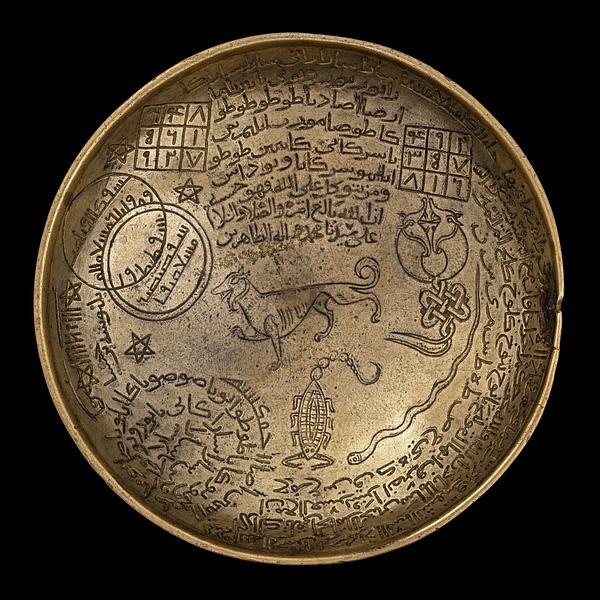Magic bowl, engraved brass
Syria; c. 1200
Diam: 11.1 cm
The dream of having a healthy child or the wish to ward off misfortune has led many Muslims throughout history to use objects that are credited with baraka (a special auspicious power).
Both magical and healing powers are attributed to this kind of bowl. When the bowl is filled with water and left overnight, the water is believed to absorb healing power from its magical signs and have a healing effect when it is drunk.
The text on the inside of the bowl includes quotations from the Koran dealing with safe childbirth and magical formulas against colic. This bowl was believed to alleviate suffering from the sting of a serpent and scorpion, and from the bite of a mad dog.
Inv. no. 36/1995
Published in:
Kjeld von Folsach, Torben Lundbæk and Peder Mortensen (eds.): Sultan, Shah and Great Mughal: the history and culture of the Islamic world, The National Museum, Copenhagen 1996, cat. 19;
Kjeld von Folsach: Art from the World of Islam in The David Collection, Copenhagen 2001, cat. 598;
Jack Hartnell: Medieval bodies: life, death and art in the middle ages, London 2018, fig. 6, pp. 23-24;
Finbarr Barry Flood: Technologies de dévotion dans les arts de l'Islam: pèlerins, reliques et copies, Paris 2019, s. 123 og fig. 26, s. 235;
Mentioned in Roberta Giunta: Islamic magic-therapeutic bowls, Roma 2018, (Aron Collection ; 1. Series catalogorum 8), p. 164, aIX p. 173, p. 285;
Joachim Meyer, Rasmus Bech Olsen and Peter Wandel: Beyond words: calligraphy from the World of Islam, The David Collection, Copenhagen 2024, cat. 126, pp. 302-303;
